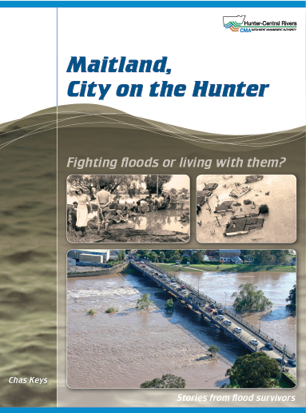
Maitland, City on the Hunter: Fighting floods or living with them? By Chas Keys
Reviewer: Dr. Stephen Yeo,
Bewsher Consulting Pty Ltd
Published by: Hunter-Central Rivers Catchment Management Authority

As a collector of flood histories, Maitland, City on the Hunter: Fighting floods or living with them? was always likely to be a winner with me. It is a flood history of the first order, benefiting from careful research and immaculately illustrated with flood photos from past eras. A feature is the seamless interplay between personal story—for example, of a farmer surviving a 20 km ride down the Hunter River in the 1955 flood—and the integrated whole.
Substantial chapters consider the 'science', the consequences and the management of floods in the Maitland area of NSW. The first of these describes significant floods from 1820 to 2007, flood-producing weather systems, patterns of flooding and influences on flood frequency. A particular strength of the 'consequences' chapter is the compilation and evaluation of the circumstances behind each of Maitland's 51 known flood fatalities. The 'management' chapter describes a fascinating evolution of a community's approach to dealing with flooding, from attempting to defeat floods to accommodating floods.
But as author Chas Keys points out, the book is not just a history but an examination of flooding, seeking to go beyond the stories to uncover the lessons learned from the community's attempts to live with floods. More than that, the book seeks to contribute to the development of a more flood-resilient Maitland. Keys is passionate but measured in his endeavour to persuade Maitlanders that future flooding is inevitable, requiring individual preparedness.
Given the stated aims, it seems clear that the book's intended primary audience are the residents of the Maitland district, few of whom would recall the devastating flood of 1955. Nevertheless, there are good reasons for commending the book to a wider audience.
First, Maitland, City on the Hunter provides an excellent example of a flood history, mining that history for lessons, and employing that history as a powerful tool in community education. Floodplain managers and other emergency managers would do well to peruse this book for ideas.
Second, scattered throughout the book is the perceptive insight of a former Deputy Director General of the NSW State Emergency Service. The reader learns about the complexities of flood intelligence, the challenges for flood warning, the imperative of the precautionary principle in evacuation decisions, and the barriers to flood education from vested interests. Lessons from other disasters both Australian and international are drawn upon for context (e.g. Hurricane Katrina).
A third reason for commending the book is its commentary on community attitudes and behaviour, perhaps its greatest strength. The enemy that confronts Maitland and many other communities in Australia is the complacency that often develops in places without a recent experience of a hazard. In the case of Maitland, the very success of the post-1955 flood mitigation works including levees has increased the separation between the community and floods. The solution proposed in the book is the purposeful instillation of 'synthetic' experience by educational processes, such as regular commemorations of the 1955 disaster.
If I were to quibble, I would wish for a more adventurous title, though the author explains why Maitland: Flood City may not have enhanced local sales! The book is also deserving of better binding. A noticeable omission is mapping of design floods such as the 100 year flood, which could contribute to the reader's 'synthetic' experience. The book does not seem to state precisely what level of protection is afforded by the modern flood mitigation scheme.
Nevertheless, the lucid style makes this book a pleasure to read (although at 141 pages, a rather lengthy read for non-Maitlanders). The experienced hazards researcher will find several points of resonance from the Maitland story, such as myths of explanation emerging after disasters, and the economic inertia that frustrates attempts to relocate hazard-prone urban centres. Learning from Maitland's long experience of dealing with floods will help emergency managers to reflect upon their own situations, to better understand their communities and consequently to better assist their communities to prepare for the inevitable, even if infrequent, hazard of the future.